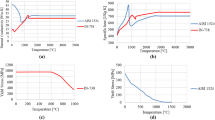Abstract
Wire and arc additive manufacturing (WAAM) is an emerging technology which has the potential to significantly reduce material usage and manufacturing time through the production of near net-shape components with high deposition rates. One of the main problems of this process is the residual stresses and distortions of the deposited workpiece. To help understand and optimise the process, finite element (FE) models are commonly used; however, the conventional transient models are not efficient for simulating a large-scale WAAM process. In this paper, the stress evolution during the thermal cycles of the WAAM process was investigated with the help of a transient thermomechanical FE model. It was found that the peak temperatures experienced during the thermal cycles of the WAAM process determine the residual stress of that point. Based on this finding, an efficient “engineering” FE model was developed. Compared to the conventional transient thermomechanical approach, this model can save the computational time by 99 %. This new model produced distortion and residual stress predictions that were nearly identical to the original transient model and the experimental results.
Similar content being viewed by others
References
Ding J, Colegrove P, Mehnen J, Ganguly S, Sequeira Almeida PM, Wang F, Williams S (2011) Thermo-mechanical analysis of wire and arc additive layer manufacturing process on large multi-layer parts. Comp Mater Sci 50:3315–3322
Sequeira Almeida PM, Williams S (2010). Innovative process model of Ti-6Al-4V additive layer manufacturing using cold metal transfer (CMT). Proceedings of the Twenty-First Annual International Solid Freeform Fabrication Symposium; University of Texas at Austin; August 9–11; 2010.
Spencer JD, Dicken PM, Wykes CM (1998) Rapid prototyping of metal parts by three-dimensional welding. Proc Inst Mech Eng Part B-J Eng Manuf 212:175–182
Clark D, Bache MR, Whittaker MT (2008) Shaped metal deposition of a nickel alloy for aero engine applications. J Mater Process Technol 203:439–448
Baufeld B, Biest OV, Gault R (2010) Additive manufacturing of Ti–6Al–4V components by shaped metal deposition: microstructure and mechanical properties. Mater Des 31:106–111
Brust FW, Kim DS (2005) Mitigating welding residual stress and distortion. In: Feng Z (ed) Processes and mechanisms of welding residual stress and distortion. Woodhead Publishing Limited, New York, pp 264–294
Staron P, Kocak M, Williams SW, Wescott A (2004) Residual stress in friction stir-welded Al sheets. Phys B: Condens Matter 350:491–493
Price DA, Williams SW, Wescott A, Harrison CJC, Rezai A, Steuwer A et al (2007) Distortion control in welding by mechanical tensioning. Sci Technol Weld Join 12:620–633
Altenkirch J, Steuwer A, Withers PJ, Williams SW, Poad M, Wen SW (2009) Residual stress engineering in friction stir welds by roller tensioning. Sci Technol Weld Join 14:185–192
Wen SW, Colegrove PA, Williams SW, Morgan SA, Wescott A, Poad M (2010) Rolling to control residual stress and distortion in friction stir welds. Sci Technol Weld Join 15:440–447
Tsai CL, Park SC, Cheng WT (1999) Welding distortion of a thin-plate panel structure. Weld J 78:156–165
Teng T, Chang P, Tseng W (2003) Effect of welding sequences on residual stresses. Comput Struct 81:273–286
Sattari-Far I, Javadi Y (2008) Influence of welding sequence on welding distortions in pipes. Int J Pressure Vessels Pip 85:265–274
Song Y, Park S, Chae S (2005) 3D welding and milling: part II—optimization of the 3D welding process using an experimental design. International Journal of Machine Tools and Manufacturing 45:1063–1069
Nickel AH, Barnett DM, Prinz FB (2001) Thermal stresses and deposition patterns in layered manufacturing. Mater Sci Eng A-Struct Mater Prop Microstruct Process 317:59–64
Mughal MP, Mufti R, Fawad H (2006) The mechanical effects of deposition patterns in welding-based layered manufacturing. Proc Inst Mech Eng Part B-J Eng Manuf 221:1499–1509
Chiumenti M, Cervera M, Salmi A, Agelet de Saracibar C, Dialami N, Matsui K (2010) Finite element modelling of multi-pass welding and shaped metal deposition processes. Comput Methods Appl Mech Eng 199:2343–2359
Camilleri D, Comlekci T, Grey TGF (2004) Computational prediction of out-of-plane welding distortion and experimental investigation. J Strain Analysis 40:161–176
Camilleri D, Mollicone P, Grey TGF (2007) Computational methods and experimental validation of welding distortion models. Proceedings of the Institution of Mechanical Engineers, Part L: Journal of Materials: Design and Applications 221:235–249
Colegrove P, Ikeagu C, Thistlethwaite A, Williams S, Nagy T, Suder W et al (2009) Welding process impact on residual stress and distortion. Science and Technology of Welding and Joining 14:717–725
Zhang L, Michaleris P (2004) Investigation of Lagrangian and Eulerian finite element methods for modelling the laser forming process. Finite Elem Anal Des 40:383–405
Wang S, Goldak J, Zhou J, Tchernov S, Downey D (2009) Simulation on the thermal cycle of a welding process by space–time convection–diffusion finite element analysis. Int J Therm Sci 48:936–947
Michaleris P, DeBiccari A (1997) Prediction of welding distortion. Weld J 76:172–181
Michaleris P, Zhang L, Bhide SR, Marugabandhu P (2006) Evaluation of 2D, 3D and applied plastic strain methods for prediction buckling welding distortion and residual stress. Sci Technol Weld Join 11:707–716
Deng D, Murakawa H (2008) Prediction of welding distortion and residual stress in a thin plate butt-welded joint. Comput Mater Sci 43:353–365
Deng D, Murakawa H, Liang W (2007) Numerical simulation of welding distortion in large structures. Comput Meth Appl Mech Eng 196:4613–4627
Goldak J, Chakravarti A, Bibby M (1984) New finite element model for welding heat sources. Metall Trans B 15B:299–305
Author information
Authors and Affiliations
Corresponding author
Rights and permissions
About this article
Cite this article
Ding, J., Colegrove, P., Mehnen, J. et al. A computationally efficient finite element model of wire and arc additive manufacture. Int J Adv Manuf Technol 70, 227–236 (2014). https://doi.org/10.1007/s00170-013-5261-x
Received:
Accepted:
Published:
Issue Date:
DOI: https://doi.org/10.1007/s00170-013-5261-x




